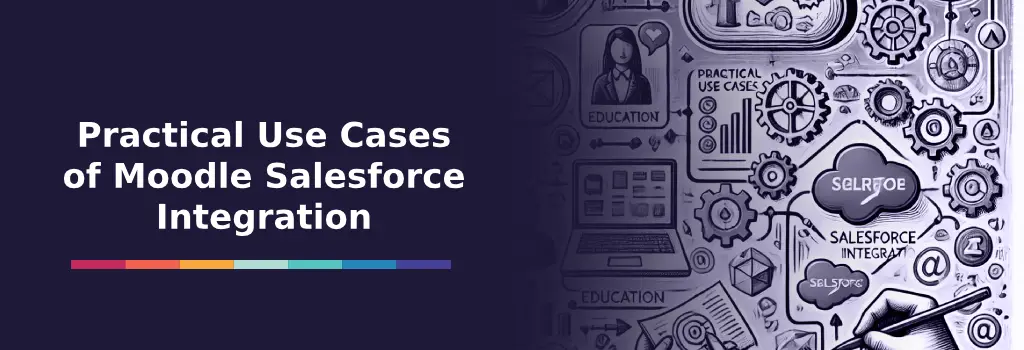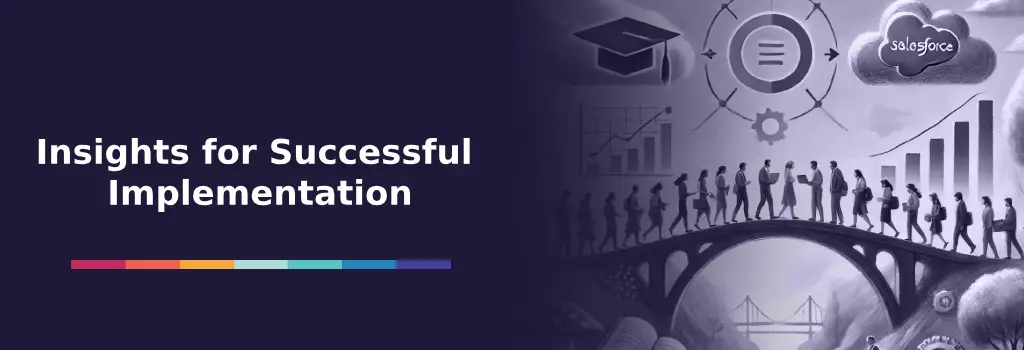Organizations that rely on Moodle for training often also depend on Salesforce for managing customer relationships, partner engagement, and sales workflows. Yet, these two platforms frequently operate in silos, leaving gaps in visibility, reporting, and user experience. Integrating Moodle with Salesforce bridges those gaps, aligning training outcomes with business results. In this article, we explore strategies for integrating Moodle and Salesforce, highlight common use cases, and share insights to ensure the integration delivers long term value.
Working with Mindfield is a life changing experience. From Product knowledge to technical expertise the team has gone above and beyond the call of duty more times then I can count.
Greg Shorland
Funeral Learning Hub
Outline
-
-
Why Connect Moodle and Salesforce
-
Practical Use Cases of Moodle Salesforce Integration
-
Strategies for Integrating Moodle and Salesforce
-
Reviewing Moodle Salesforce Plugins and the Case for Custom Integration
-
Insights for Successful Implementation
-
Explore More Integration Strategies
-
Expert Guidance for a Seamless Salesforce Connection
-
Frequently Asked Questions(FAQs)
-
Why Connect Moodle and Salesforce

The question of why Moodle and Salesforce should be integrated often arises in organizations that already manage both systems effectively on their own. The answer lies in the value of unifying information. Moodle tracks course completions, assessments, certifications, and learner engagement. Salesforce manages accounts, opportunities, support cases, and partner performance. Without integration, these two data sets exist in isolation, requiring manual work to combine or interpret them.
Connecting Moodle and Salesforce allows for real time sharing of learning data within business processes. For example, sales managers can see whether new representatives have completed onboarding modules before assigning them to active deals. Partner managers can verify that external partners are properly certified before renewing contracts. Customer success teams can check whether clients have completed required training programs during onboarding or before support escalations.
The benefits extend beyond operational convenience. By centralizing data, executives gain visibility into the impact of training programs on revenue generation, customer retention, and compliance outcomes. Manual data entry is eliminated, accuracy improves, and training stops being an isolated activity. Instead, learning becomes a measurable and strategic driver of growth.
Practical Use Cases of Moodle Salesforce Integration

The value of Moodle Salesforce integration is best understood through real scenarios. Here are some of the most common and impactful use cases:
-
Partner Certification: Partner organizations often need to maintain certifications in order to represent a product or service. Moodle tracks partner learners through certification courses, while Salesforce manages the partner account itself. Integration ensures that only partners who have successfully completed required training appear as active and certified within Salesforce. This prevents lapses that could create compliance risks or reputational issues.
-
Customer Onboarding: Successful onboarding is essential for customer satisfaction and retention. Moodle delivers structured training to new customers, while Salesforce manages the customer relationship. When completions flow automatically into Salesforce, account managers can monitor onboarding progress in real time and proactively support customers who may be falling behind.
-
Sales Enablement: Sales representatives need ongoing training to stay effective, whether learning about new products, competitive updates, or compliance requirements. By integrating Moodle with Salesforce, training resources can be surfaced directly within the Salesforce interface. This reduces friction and makes it easy for sales teams to access the right content at the right time.
-
Compliance Tracking: In industries with regulatory oversight, compliance training is non negotiable. Moodle provides detailed completion records, but without integration, compliance data often remains in a silo. By syncing completion data into Salesforce, leadership teams gain a single source of truth for audits and regulatory reporting. This reduces risk and builds trust with regulators and clients.
These use cases demonstrate that the value of integration is not limited to efficiency. It enhances business outcomes by embedding training within the workflows that matter most.
Strategies for Integrating Moodle and Salesforce

There is no single path to integrating Moodle with Salesforce. Organizations need to choose the approach that best fits their size, budget, and complexity of use cases. The three main strategies are direct API integration, middleware or connectors, and custom plugin development.
1. Direct API Integration
Moodle provides web services and Salesforce offers a robust API layer. With direct API integration, developers can configure custom endpoints that sync users, enrollments, and completions between the systems. The advantage of this method is flexibility, since organizations can define exactly which data flows and how it is transformed. However, it requires a skilled technical team and an ongoing commitment to maintenance as either platform updates. This strategy works well for organizations that want maximum control over the integration and already have in house technical capacity.
2. Middleware or Connector Tools
For organizations that prefer a quicker and less technical solution, middleware platforms such as Zapier, MuleSoft, or prebuilt Moodle Salesforce connectors provide a strong option. These tools come with templates for syncing users, enrollment data, course completions, and certificates. They can often be set up with limited coding, which reduces time to deployment. The tradeoff is reduced flexibility compared to custom API integration. Middleware is ideal for organizations that want reliable functionality without heavy investment in custom code.
3. Custom Plugins for Specialized Workflows
In some cases, off the shelf connectors do not support unique organizational needs. For example, multi tenant Moodle environments may require different data flows for each tenant, or advanced analytics setups may need to push data into Salesforce in a specific structure. In these cases, custom plugin development provides the best outcome. This approach ensures the integration is tailored precisely to the business processes in place. Although custom plugins require more effort to build and maintain, they offer the greatest alignment between Moodle training data and Salesforce workflows.
When evaluating these strategies, decision makers should weigh cost, scalability, data governance, and the long term roadmap. A short term solution may solve an immediate need, but a strategic choice ensures the integration continues to support growth for years to come.
Reviewing Moodle Salesforce Plugins and the Case for Custom Integration

Several third-party solutions attempt to connect Moodle and Salesforce, each with different levels of maturity, flexibility, and technical depth. While these integrations can simplify implementation, the right choice depends on your organization’s workflows, data structure, and scalability goals. Below we review three of the most recognized options: Custom API Integrationm, EnlightenCRM (AppExchange), Paradiso Solutions, and Lingel Learning, highlighting their strengths, weaknesses, and best-fit scenarios.
1. Custom API Integration
Custom API integration uses Moodle Web Services and Salesforce REST/SOAP APIs to build a fully tailored, bi-directional connection. This is often the most strategic long-term approach for organizations with complex data requirements.
Strengths
-
Maximum flexibility — every field, trigger, and workflow can be customized.
-
Works with any Moodle setup, including heavily customized or multi-tenant deployments (Iomad).
-
Most scalable option for long-term growth and advanced reporting (custom objects, automation, triggers).
-
Eliminates dependency on vendor release cycles.
Weaknesses
-
Requires technical expertise (API authentication, middleware logic, error handling).
-
Higher up-front implementation effort.
-
Requires ongoing governance to handle API changes from Moodle or Salesforce.
Rating: 5/5
Best for:
Organizations with IT resources, complex Salesforce objects, strict data security requirements, or long-term multi-system architecture plans.
2. EnlightenCRM (AppExchange Listing)
Source: Salesforce AppExchange
Developed by Remote Learner, EnlightenCRM is a Salesforce-native connector that embeds Moodle learning data directly into Salesforce dashboards. As an official AppExchange listing, it benefits from Salesforce’s vetting process for security and compatibility.
Strengths
-
Deep Salesforce integration with clean installation and minimal configuration.
-
Supports syncing user data, course completions, and certifications directly to CRM records.
-
Designed to make Salesforce the single source of truth for training visibility and reporting.
Weaknesses
-
Limited technical documentation and few public case studies make performance validation difficult.
-
Reduced flexibility for complex Moodle structures such as multi-tenancy or customized course workflows.
-
Licensing costs and dependency on Salesforce’s release cycle may add long-term overhead.
Rating: 4/5
Best for: Salesforce-driven organizations seeking fast deployment with reliable CRM visibility, without heavy Moodle customization.
3. Paradiso Solutions
Source: Paradiso Solutions Blog
Paradiso Solutions provides a commercial Moodle-based LMS with built-in Salesforce integration. Their solution supports bi-directional data exchange, enabling training activity to influence CRM records and vice versa.
Strengths
-
Broad feature coverage: user sync, enrolment automation, certification management, and reporting.
-
Multi-tenant support ideal for partner or reseller training programs.
-
Vendor-maintained connector that reduces internal development effort.
Weaknesses
-
Primarily optimized for Paradiso LMS rather than open-source Moodle, limiting flexibility for custom deployments.
-
Some users report slower response times and steep learning curves during setup.
-
Costs and contract structures vary depending on the scale of implementation.
Rating: 4/5
Best for: Organizations using Paradiso LMS or those prioritizing turnkey integrations with vendor-managed maintenance.
4. Lingel Learning
Source: Lingel Learning
Lingel Learning, a Moodle Certified Premium Partner in Australia and Canada, offers a direct plugin that connects Moodle with Salesforce. It enables user synchronization, enrolment updates, and completion tracking between systems.
Strengths
-
Developed by a trusted Moodle Certified Partner with strong technical credentials.
-
Retains Moodle as the core LMS while seamlessly extending data to Salesforce.
-
Straightforward configuration for user, course, and cohort mapping.
Weaknesses
-
Limited public performance reviews or large-scale case studies.
-
Manual setup may require coordination between Moodle and Salesforce administrators.
-
Additional development effort needed for complex Salesforce objects or analytics requirements.
Rating: 3/5
Best for: Standard Moodle implementations seeking a certified, reliable connector that balances simplicity with control.
Summary Comparison
| Integration Option | Rating | Best For | Key Limitations |
|---|---|---|---|
| Custom API Integration | ★★★★★ | Complex workflows, long-term scalability, multi-tenant setups | Requires technical expertise & governance |
| EnlightenCRM (AppExchange) | ★★★★☆ | Salesforce-centric workflows | Limited Moodle flexibility, proprietary maintenance |
| Paradiso Solutions | ★★★★☆ | Partner training programs, multi-tenant LMS environments | Optimized for Paradiso LMS; vendor dependency |
| Lingel Learning Plugin | ★★★☆☆ | Standard Moodle instances | Requires manual configuration, few public reviews |
Insights for Successful Implementation

While integration offers great promise, organizations often encounter challenges when moving from concept to execution. Based on real world experience, several insights can help ensure a smooth and successful implementation.
-
Start with Clear Data Goals: Before building anything, identify which data fields should be shared between Moodle and Salesforce. Not all information is equally valuable. Focus on data that directly influences business outcomes, such as course completions, certifications, and learner status. This avoids clutter and ensures the integration supports decision making.
-
Prioritize User Experience: The success of the integration is not measured only by the technical connection but also by how easily users interact with the systems. For learners and sales representatives, a seamless single sign on experience can significantly reduce friction. For managers, dashboards in Salesforce that clearly display learning progress ensure adoption and satisfaction.
-
Plan for Governance and Maintenance: Integration is not a one time project. Both Moodle and Salesforce release regular updates, which can affect compatibility. Establish clear ownership for monitoring the integration, performing updates, and managing security. A governance plan prevents small issues from becoming major disruptions.
-
Test Extensively Before Launch: Pilot programs are invaluable for validating assumptions. By testing data mappings, user flows, and reports with a smaller group, organizations can identify errors before scaling to the entire workforce or partner network. Testing also builds confidence among stakeholders, which is critical for adoption.
Organizations that follow these insights are more likely to achieve an integration that is stable, scalable, and aligned with business goals.
Explore More Integration Strategies
This article is part of a broader series covering how Moodle can connect with other platforms or evolve its architecture. You might also find these guides useful as you explore your integration or migration options:
-
How to Migrate Thinkific to Iomad — step-by-step breakdown of transitioning courses and users from Thinkific into a multitenant Moodle setup
-
How to Migrate from Moodle to Iomad — how to convert an existing single Moodle instance into a multitenant structure with tenant isolation
-
Moodle Multi Tenancy Plugin Overview — deep dive into multi tenancy plugins, their features, and best practices
-
How to Enable Moodle Learning Paths — guide for configuring structured learning progression inside Moodle
-
How to Migrate from Docebo to Moodle — migrating content, users, and assessments from Docebo into Moodle
-
SharePoint to Moodle Migration Strategies — tactics for moving documents, collaboration content, and user workflows from SharePoint into Moodle
-
Migrate from Canvas to Moodle — converting Canvas courses, quizzes, and data into the Moodle environment
-
Migrating Moodle from Single to Multitenancy — best practices when evolving from a standalone Moodle instance to a multitenant design
-
Migrate from Google Classroom to Moodle — steps for importing course content and user data from Google Classroom into Moodle
-
Migrate from Totara to Moodle — strategies for converting Totara’s features (certifications, hierarchy, reports) into Moodle equivalents
Each of these guides describes a different angle of migration or integration. Together, they form a toolkit for organizations looking to build a cohesive and scalable learning ecosystem that extends beyond Moodle alone.
Expert Guidance for a Seamless Salesforce Connection

Integrating Moodle with Salesforce can unlock enormous value, but it is rarely a simple plug and play project. The process involves configuring APIs, mapping data correctly, ensuring compliance with security policies, and aligning workflows across both systems. Without experienced guidance, organizations risk data errors, broken processes, or costly rework.
Hiring Moodle experts ensures the integration is both technically sound and strategically aligned with business goals. Experts bring experience with previous implementations, which helps avoid common pitfalls and accelerates deployment. They can:
-
Design the Right Integration Approach: Determine whether direct APIs, middleware connectors, or custom plugins best fit your organization’s needs.
-
Ensure Data Accuracy: Map fields correctly to avoid missing completions, duplicate users, or incomplete records in Salesforce.
-
Improve User Experience: Configure seamless single sign on, intuitive dashboards, and efficient workflows for both learners and managers.
-
Provide Ongoing Support: Keep the integration running smoothly as Moodle and Salesforce release updates, ensuring long term reliability.
By working with experts, organizations transform integration from a technical challenge into a business advantage. The result is a learning ecosystem that not only works reliably but also drives measurable improvements in sales, compliance, and customer success.

